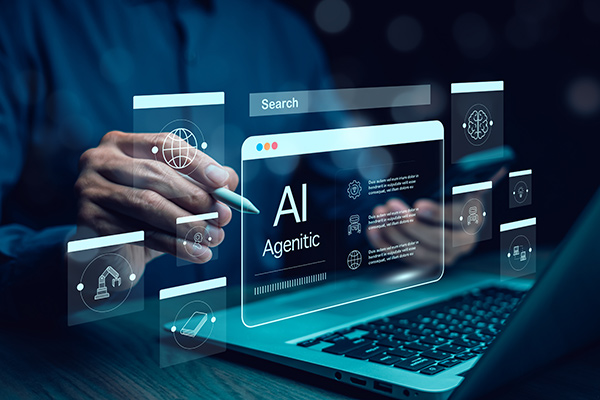Agentic AI is redefining supply chains—turning data, decisions, and disruption into intelligent, autonomous collaboration.
By Jan Burian
Supply chain organizations are facing unprecedented complexity. Global disruptions, volatile demand, sustainability pressures, and evolving customer expectations are pushing traditional systems to their limits. While most companies have already invested in analytics, cloud platforms, and digital twins, the next big leap in performance is coming from agentic AI—autonomous or semi-autonomous software entities capable of perceiving their environment, making decisions, and taking actions to achieve defined goals.
Once confined to research labs and simulations, AI agents are now entering real-world supply chain operations. Their ability to learn, collaborate, and act in real time is transforming how companies plan, source, produce, and deliver.

Agentic AI represents a fundamental shift in how artificial intelligence is designed and deployed. Unlike traditional AI systems that execute predefined tasks based on static algorithms, agentic AI builds on entities that operate with a degree of autonomy. These agents can sense their environment through data, reason about what they perceive, and act upon it—either individually or in coordination with others.
As Maggie Slowik, Global Industry Director, IFS, puts it: “Agentic AI isn’t just another layer of automation: it’s a mindset shift. For manufacturers dealing with constant variability, AI agents offer more than insight: they enable action!”
This is particularly relevant in supply chains, where conditions change by the minute. Agentic AI systems are environment-aware, capable of continuously adjusting to new information such as fluctuating inventory levels, transport delays, or supplier disruptions. They handle complex decision-making in real time and often operate without direct human instruction, freeing experts to focus on strategy rather than routine interventions.
In short, agentic AI brings adaptability, autonomy, and intelligence to processes that were once rigid and reactive.
Supply chains are networks of dependencies—spanning suppliers, manufacturers, logistics providers, distributors, and customers. Traditional AI tools can optimize certain steps, but they rarely coordinate decisions across the entire chain. Agentic AI, however, thrives in this complexity.
Agents can continuously learn from outcomes, recognize patterns, and collaborate toward shared goals. A logistics agent might reroute shipments in response to a port closure, while a warehouse agent dynamically reallocates picking labor. An inventory agent can adjust reorder points based on real-time sales or production data, and a network agent can proactively identify and mitigate supplier risks.
When orchestrated together, these agents create a self-correcting system—one that learns from every action and becomes smarter with time. This evolution marks a shift from linear supply chain management to living, learning supply networks.
Recent industry research highlights just how fast agentic AI is moving from theory to practice. According to Inspectorio’s State of Supply Chain Report 2025, fewer than 10% of companies have reached near-full automation in key supply chain functions, and more than 45% remain below 25% digitalization. The opportunity for intelligent automation is immense.
Capgemini’s Supply Chain Survey 2025 found that 67% of executives believe agentic AI will directly increase productivity, and 58% expect it to revolutionize supply chain frameworks and processes. Two-thirds of organizations anticipate that, within the next three to five years, agentic systems will handle most supply chain decisions.
Meanwhile, Gartner projects that by 2030, half of all cross-functional supply chain management solutions will include agentic AI capabilities. Many companies have already begun preparing: 27% report having dedicated teams, and nearly 20% are piloting or implementing early multi-agent systems.
The data paints a clear picture—AI agents are not a futuristic concept; they’re the foundation of the next generation of digital supply chains.
Organizations deploying agentic AI are realizing measurable benefits. These systems drive productivity gains, reduce operational costs, and improve resilience by detecting and responding to disruptions faster than human teams alone.
Capgemini’s modeling suggests agentic AI can cut overall supply chain costs by around 5%, with logistics expenses reduced by up to 10%. But beyond cost, the qualitative improvements are even more significant: faster decision-making, greater agility, and the ability to continuously adapt to change.
In practice, AI agents can perform root-cause analysis of inventory anomalies, identify quality issues early, manage labor and picking operations in warehouses, and dynamically reconfigure logistics networks in response to external events. In each case, they translate raw data into actionable decisions—instantly and autonomously.
Despite the promise, adoption is not without its challenges. The first barrier is data quality: agents depend on timely, accurate, and harmonized data. Many enterprises still struggle with fragmented legacy systems and inconsistent information across tiers.
Equally important are trust and governance. As AI agents begin to act autonomously, leaders must ensure transparency, explainability, and compliance. It’s not enough to know what an agent decided; organizations must also understand why.
Integration is another obstacle, as agentic AI often needs to connect with ERP, WMS, and planning systems that were not designed for real-time autonomous decision-making. Moreover, not all use cases justify the investment—companies need to start where data is strong and impact is clear.
The future of supply chain management is unlikely to be fully autonomous in the near term—but it will be deeply collaborative. Human expertise and AI autonomy will coexist, each amplifying the other’s strengths. Agents will handle the time-sensitive, repetitive, and data-intensive aspects of operations, while humans oversee strategy, exception handling, and ethics.
Orchestration platforms will emerge as the connective layer, coordinating dozens of specialized agents across planning, production, logistics, and fulfillment. The vision is not of a supply chain ruled by AI, but of one continuously optimized by it—faster, more intelligent, and more resilient in the face of uncertainty.
Agentic AI represents one of the most profound technological shifts in supply chain management. It replaces static automation with dynamic, data-driven autonomy, enabling systems that sense, decide, and act with increasing sophistication.
For organizations that invest in high-quality data, strong governance, and purposeful use cases, the rewards are significant: faster response times, reduced costs, higher resilience, and a supply chain that continuously learns and improves.
The next frontier of supply chain excellence won’t just be digital—it will be agentic.

About the Author:
Jan Burian, a global analyst, author, and speaker, serves as the Head of Industry Insights at Trask. His expertise spans digital transformation, management, leadership, and the geopolitical influences shaping manufacturing and global supply chains. Prior to his role at Trask Solutions, Jan led Manufacturing Insights Europe at IDC and held consulting positions at EY and Deloitte.
In this episode, I sat down with Beejan Giga, Director | Partner and Caleb Emerson, Senior Results Manager at Carpedia International. We discussed the insights behind their recent Industry Today article, “Thinking Three Moves Ahead” and together we explored how manufacturers can plan more strategically, align with their suppliers, and build the operational discipline needed to support intentional, sustainable growth. It was a conversation packed with practical perspectives on navigating a fast-changing industry landscape.